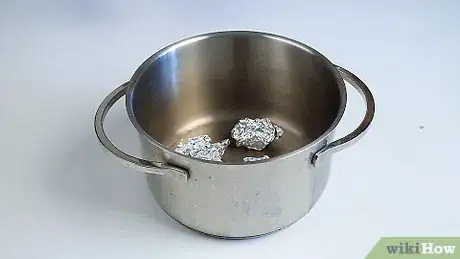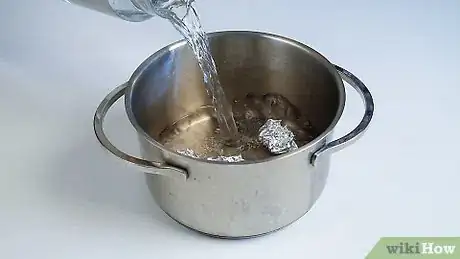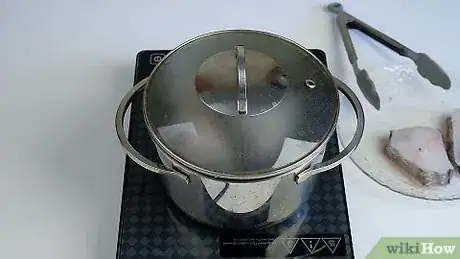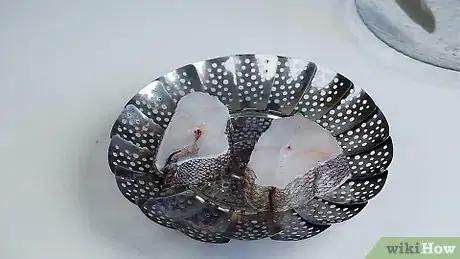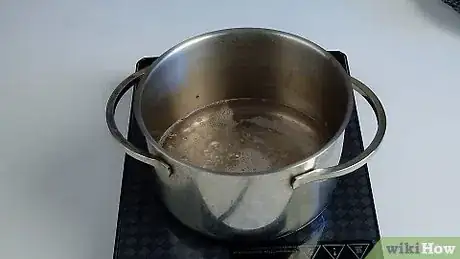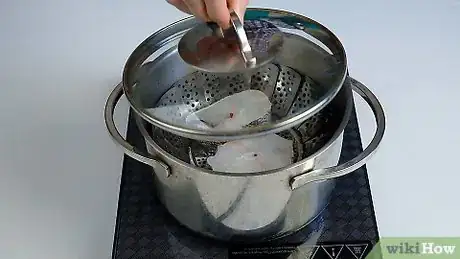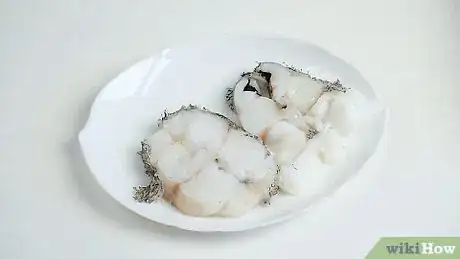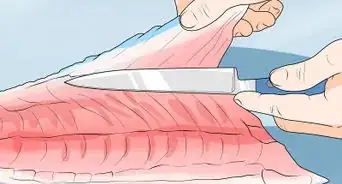This article was co-authored by wikiHow Staff. Our trained team of editors and researchers validate articles for accuracy and comprehensiveness. wikiHow's Content Management Team carefully monitors the work from our editorial staff to ensure that each article is backed by trusted research and meets our high quality standards.
There are 13 references cited in this article, which can be found at the bottom of the page.
The wikiHow Video Team also followed the article's instructions and verified that they work.
This article has been viewed 36,978 times.
Learn more...
Steaming fish is a great way to lock in its natural flavor and nutrients without worrying about ruining its delicate texture or ratcheting up the calories. The easiest way to steam a fresh fish dinner to perfection is to simply pop it in a steamer oven. If you don’t own one of these handy devices, however, you can easily rig up your own makeshift steamer using only an ordinary pot or pan, a cooking ring or steamer basket, and a couple inches of water.
Steps
Using a Heat-Proof Plate and Cooking Ring
-
1Place a stainless steel cooking ring in the center of a shallow pot. A cooking ring is small molded metal ring that is ordinarily used to cook various foods into a neat circular shape. When placed at the bottom of your pot, however, it will serve as a buffer between the boiling water you’ll be using to steam your fish and the plate you’ll be steaming it on.[1]
- Make sure you use a pot deep enough to hold both the cooking ring and steamer plate with the lid on.
- It’s important that the cooking ring you use be made of metal. Plastic rings will melt and fuse to your pot in a heartbeat!
- If you don’t have a cooking ring, you might also use a large cookie cutter or similar food-shaping utensil, provided it’s also made from stainless steel.
Tip: Assuming you’re without a cooking ring or a cookie cutter, another thing you can do is crumple 3-4 pieces of aluminum foil into 2 in (5.1 cm) balls and use them to elevate your steamer plate.[2]
-
2Add about 2 inches (5.1 cm) of water to the pot. You may need to use slightly more or less water, depending on the size of your pot and cooking ring. The water should come up to just below the top of the ring, cookie cutter, or aluminum foil balls.[3]
- Make sure the water level isn’t higher than the edges of your steamer plate. Otherwise, you may inadvertently end up poaching your fish instead.
Advertisement -
3Set a heat-safe plate smaller than your pot on the cooking ring. Center the plate on top of the cooking ring or foil balls to ensure that it’s secure. It needs to be able to support the weight of the fish you’ll be steaming without tipping over.[4]
- If you're not sure whether the plate you want to use is heat-safe, check the underside for the words "Heat-Safe" or "Microwave-Safe," or a symbol featuring three wavy lines inside a tiny microwave.[5]
- These days, most types of brand-name dining ware are heat-safe.
-
4Turn on the cooktop to medium-high heat and bring the water to a low boil. You can season your fish or tend to any other dishes you’re preparing as you wait for your water to heat up. When steam begins escaping steadily from the pot, it will be time to add your fish.[6]
- Once the water reaches a rolling boil, turn it down just a little to keep it from bubbling up onto your steamer plate.
-
5Add your fish to the steamer plate. Lower the fish onto the plate quickly and carefully. It should be safe to do this by hand, but you can also use a pair of tongs if you're worried about being burned by the steam, which should be flowing freely by now. Leave at least 1⁄2 inch (1.3 cm) of space between each piece to prevent sticking or uneven heating.[7]
- Distribute the weight of your fish evenly around the middle of the plate—this will prevent it from tipping or shifting off of the cooking ring.
- Your steamer plate will most likely only accommodate 2-4 whole fish or fillets. If you plan on steaming a large quantity of fish, it might be necessary to do so in batches.
-
6Cover the pot and steam the fish for 5-7 minutes. This should be enough time for small fish and fillets to reach the perfect tender texture. You'll know your fish is done when it's taken on an even opaque color and is delicate enough to flake with a fork.[8]
- Especially large or thick cuts, such as tuna or swordfish steaks, may need closer to 10 or 12 minutes to cook all the way through.[9]
- Set a timer so you won't accidentally forget about your fish if you get busy doing other things.
-
7Remove the plate from your steamer setup using a potholder or oven mitt. It will be extremely hot, so be careful. Set the plate on a heat-resistant surface and serve the fish while it’s nice and hot. Be sure to drain the excess juice from your steamed fish before plating it.
- You can also save the juices and pour them back over the fish to reincorporate them, or reduce them into a flavorful sauce.[10]
Using a Steamer Basket
-
1Arrange your fish inside your steamer basket. Once you’ve seasoned your whole fish or fillets to taste, place them at the bottom of the basket in a single layer. Leave at least 1⁄2 inch (1.3 cm) of space between each piece of fish to prevent sticking or uneven heating.[11]
- You can pick up a stainless steel, silicone, or bamboo steamer basket from any home goods store for as little as $20. They make a great addition to any kitchen, especially if steaming is among your preferred cooking methods.
- If you’re using a bamboo basket, line the bottom surface with a layer of parchment paper or lettuce, cabbage, or banana leaves before adding your fish. This will keep it from clinging to the moist wood.[12]
-
2Fill a pot with 1–2 inches (2.5–5.1 cm) of water. Feel free to use more or less water as needed. Just make sure that the water level remains below the bottom edge of your steamer basket so that it doesn’t spill over onto your fish.[13]
- If your steaming water actually comes into contact with your fish, it could make it soggy or even cause it to fall apart.
Tip: For even more flavor, you also have the option of using other types of liquids for steaming, such as broths, stocks, and cooking wines.[14]
-
3Bring the water to a boil over medium-high heat. Place the pot on the cooktop and switch on the burner. Allow the water to warm up for 5-6 minutes, or as long as it takes to reach a full boil. You want it to be putting off a thick curtain of steam by the time you add your fish.
- Reduce your cooking temperature to a low boil if space inside your pot is limited.
-
4Set the steamer basket inside the pot. Most steamer baskets are designed to slip right inside any pot with a larger diameter. Some even have ridges that allow them to be hooked onto the rim of a pot or pan, ensuring that they stay put and hover well above the boiling water.[15]
- Lower the steamer basket quickly to minimize the risk of burns. Just be careful not to drop the basket or the fish itself, as this could send boiling water splashing everywhere!
- You may have an easier time getting a bamboo steamer basket in and out of a shallow sauté pan or wok, which is how they’re traditionally used.[16]
-
5Cover the pot up tight. Place lid on top of the pot and double-check that it's secure. If it’s even slightly ajar, some of the steam may leak out, decreasing the temperature inside the pot and therefore increasing your cook time.
- You should be able to tell right away if steam is escaping from the pot.
-
6Steam the fish for 5-7 minutes. Be prepared to give thick, dense fillets and steaks a little longer, up to 10-12 minutes. Fully cooked fish will turn opaque all the way through and flake easily with a fork. If you like, you can lift the lid on the pot momentarily to monitor your fish's progress.[17]
- Investing in a collapsible steamer basket with a built-in handle will make removing your finished foods a breeze.
- One of the biggest advantages of steaming over other cooking methods is that even if you accidentally overcook your fish, it won’t dry out or lose any of its delectable juices.[18]
-
7Use a potholder or oven mitt to safely extract your steamer basket from the pot. Rest the basket on a heat-resistant countertop or similar surface until you're ready to plate the fish. Most steamer baskets are slotted, so there should be no need to drain it before serving. Bon appétit!
- It's a good idea to use your potholder or oven mitt to take the lid off of the pot, too, since it will have absorbed quite a bit of heat.
- Oven mitts with individual finger slots are perfectly suited for tasks like this that require a little more dexterity.[19]
Warnings
- Unlike with most meats, consuming partially undercooked fish isn’t generally considered a health risk. For safety’s sake, however, it’s still recommended that you serve fish at an internal temperature of at least 145 °F (63 °C).[20]⧼thumbs_response⧽
Things You’ll Need
Using a Heat-Proof Plate and Cooking Ring
- Shallow lidded pot or pan
- Stainless steel cooking ring
- Heat-safe plate
- Water
- Potholder or oven mitt
- Cookie cutter or similar food-shaping utensil (optional)
- Aluminum foil (optional)
Using a Steamer Basket
- Shallow lidded pot or pan
- Stainless steel, silicone, or bamboo steamer basket
- Water
- Potholder or oven mitt
- Wok (optional)
- Parchment paper (optional—for bamboo baskets)
- Lettuce, cabbage, or banana leaves (optional—for bamboo baskets)
References
- ↑ https://www.youtube.com/watch?v=bNC8AvgOPR8&feature=youtu.be&t=7
- ↑ https://food52.com/blog/21698-how-to-steam-fish
- ↑ https://www.foodandwine.com/video/how-steam-without-steamer
- ↑ https://www.youtube.com/watch?v=bNC8AvgOPR8&feature=youtu.be&t=19
- ↑ https://www.realsimple.com/food-recipes/tools-products/cookware-bakeware/food-containers-safe-for-microwave
- ↑ https://www.foodandwine.com/video/how-steam-without-steamer
- ↑ https://www.youtube.com/watch?v=bNC8AvgOPR8&feature=youtu.be&t=40
- ↑ https://www.foodandwine.com/video/how-steam-without-steamer
- ↑ https://food52.com/blog/21698-how-to-steam-fish
- ↑ https://www.foodandwine.com/blogs/10-quick-sauces-fish
- ↑ http://fishonfriday.org.uk/how-to-steam-fish/
- ↑ https://www.youtube.com/watch?v=ACkyk7LmzvM&feature=youtu.be&t=71
- ↑ https://www.thekitchn.com/how-to-use-a-bamboo-steamer-ba-127621
- ↑ https://food52.com/blog/21698-how-to-steam-fish
- ↑ https://www.youtube.com/watch?v=zTb51nWt9Os&feature=youtu.be&t=46
- ↑ https://www.thekitchn.com/how-to-use-a-bamboo-steamer-ba-127621
- ↑ https://www.foodandwine.com/video/how-steam-without-steamer
- ↑ https://food52.com/blog/21698-how-to-steam-fish
- ↑ https://www.reviewed.com/cooking/best-right-now/the-best-oven-mitts
- ↑ https://www.fsis.usda.gov/wps/portal/fsis/topics/food-safety-education/get-answers/food-safety-fact-sheets/safe-food-handling/safe-minimum-internal-temperature-chart/ct_index
